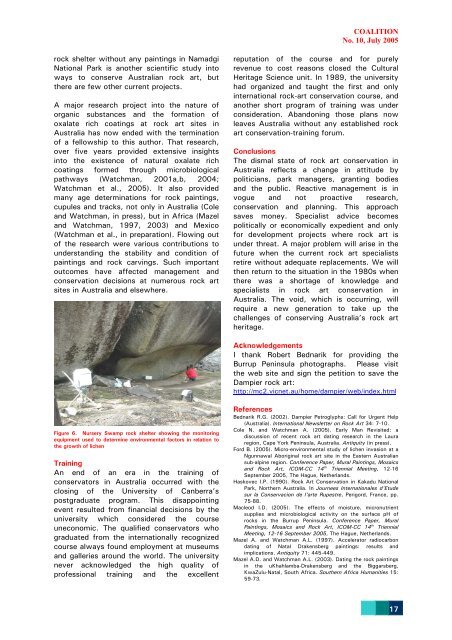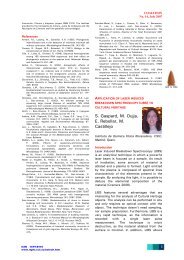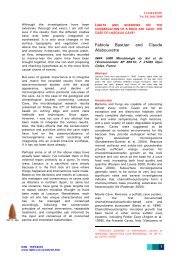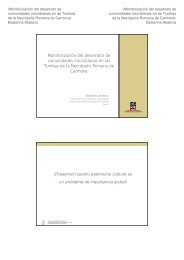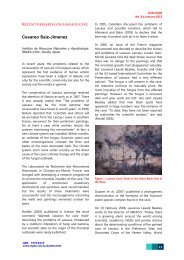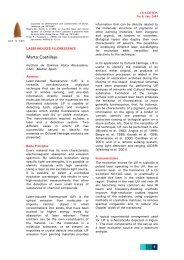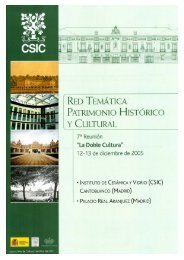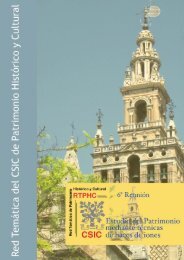Alan Watchman
Alan Watchman
Alan Watchman
- No tags were found...
You also want an ePaper? Increase the reach of your titles
YUMPU automatically turns print PDFs into web optimized ePapers that Google loves.
COALITIONNo. 10, July 2005rock shelter without any paintings in NamadgiNational Park is another scientific study intoways to conserve Australian rock art, butthere are few other current projects.A major research project into the nature oforganic substances and the formation ofoxalate rich coatings at rock art sites inAustralia has now ended with the terminationof a fellowship to this author. That research,over five years provided extensive insightsinto the existence of natural oxalate richcoatings formed through microbiologicalpathways (<strong>Watchman</strong>, 2001a,b, 2004;<strong>Watchman</strong> et al., 2005). It also providedmany age determinations for rock paintings,cupules and tracks, not only in Australia (Coleand <strong>Watchman</strong>, in press), but in Africa (Mazeland <strong>Watchman</strong>, 1997, 2003) and Mexico(<strong>Watchman</strong> et al., in preparation). Flowing outof the research were various contributions tounderstanding the stability and condition ofpaintings and rock carvings. Such importantoutcomes have affected management andconservation decisions at numerous rock artsites in Australia and elsewhere.reputation of the course and for purelyrevenue to cost reasons closed the CulturalHeritage Science unit. In 1989, the universityhad organized and taught the first and onlyinternational rock-art conservation course, andanother short program of training was underconsideration. Abandoning those plans nowleaves Australia without any established rockart conservation-training forum.ConclusionsThe dismal state of rock art conservation inAustralia reflects a change in attitude bypoliticians, park managers, granting bodiesand the public. Reactive management is invogue and not proactive research,conservation and planning. This approachsaves money. Specialist advice becomespolitically or economically expedient and onlyfor development projects where rock art isunder threat. A major problem will arise in thefuture when the current rock art specialistsretire without adequate replacements. We willthen return to the situation in the 1980s whenthere was a shortage of knowledge andspecialists in rock art conservation inAustralia. The void, which is occurring, willrequire a new generation to take up thechallenges of conserving Australia’s rock artheritage.AcknowledgementsI thank Robert Bednarik for providing theBurrup Peninsula photographs. Please visitthe web site and sign the petition to save theDampier rock art:http://mc2.vicnet.au/home/dampier/web/index.htmlFigure 6. Nursery Swamp rock shelter showing the monitoringequipment used to determine environmental factors in relation tothe growth of lichenTrainingAn end of an era in the training ofconservators in Australia occurred with theclosing of the University of Canberra’spostgraduate program. This disappointingevent resulted from financial decisions by theuniversity which considered the courseuneconomic. The qualified conservators whograduated from the internationally recognizedcourse always found employment at museumsand galleries around the world. The universitynever acknowledged the high quality ofprofessional training and the excellentReferencesBednarik R.G. (2002). Dampier Petroglyphs: Call for Urgent Help(Australia). International Newsletter on Rock Art 34: 7-10.Cole N. and <strong>Watchman</strong> A. (2005). Early Man Revisited: adiscussion of recent rock art dating research in the Lauraregion, Cape York Peninsula, Australia. Antiquity (in press).Ford B. (2005). Micro-environmental study of lichen invasion at aNgunnawal Aboriginal rock art site in the Eastern Australiansub-alpine region. Conference Paper, Mural Paintings, Mosaicsand Rock Art, ICOM-CC 14 th Triennial Meeting, 12-16September 2005, The Hague, Netherlands.Haskovec I.P. (1990). Rock Art Conservation in Kakadu NationalPark, Northern Australia. In Journees Internationales d'Etudesur la Conservacion de l'arte Rupestre, Perigord, France, pp.75-88.Macleod I.D. (2005). The effects of moisture, micronutrientsupplies and microbiological activity on the surface pH ofrocks in the Burrup Peninsula. Conference Paper, MuralPaintings, Mosaics and Rock Art, ICOM-CC 14 th TriennialMeeting, 12-16 September 2005, The Hague, Netherlands.Mazel A. and <strong>Watchman</strong> A.L. (1997). Accelerator radiocarbondating of Natal Drakensberg paintings: results andimplications. Antiquity 71: 445-449.Mazel A.D. and <strong>Watchman</strong> A.L. (2003). Dating the rock paintingsin the uKhahlamba-Drakensberg and the Biggarsberg,KwaZulu-Natal, South Africa. Southern Africa Humanities 15:59-73.17


